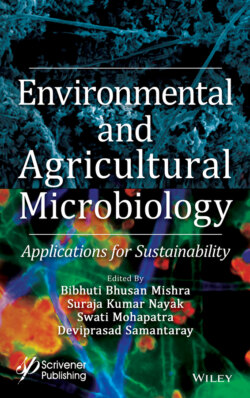Читать книгу Environmental and Agricultural Microbiology - Группа авторов - Страница 47
3.1 Introduction
ОглавлениеIn current days, industrial, domestic, agriculture, and anthropogenic activity increase due to increasing population and demand of society. Therefore, new pollutants are present in different sources. Some of them are not degradable or take several years for degradation like xenobiotic and heavy metals. They are present in many forms in soil and water, enter in food chain of animal, plant, and human, and create diseases and several physical and physiological disorders. In recent days, heavy metal waste production is more from anthropogenic and industrial sources and these are creating serious problem to our surrounding and causing several diseases like cancer, skin lesions, birth defect, cerebral and bodily retention, gain knowledge disability, and malfunction of liver and kidney [1]. Therefore, heavy metal pollution has become a headache to our society. The metals and metalloids are heavy metals and biologically classified into two categories: essential [manganese (Mn), zinc (Zn), cobalt (Co), copper (Cu), and chromium (Cr)] and nonessential [cadmium (Cd), lead (Pb), and mercury (Hg)] elements [2]. The low concentration of essential heavy metal is required for animal, plant, and human nutrition, and non-essential element is generally known as toxic element for living beings [3, 4]. The treatment of toxic elements by biological process is better than physical and chemical process because of cost effectiveness and environmental compatibility. The potential of biofilm communities for biodetoxification methods has currently been realized [5]. The biodetoxification of heavy metals can be possible by immobilization, volatilization, concentration, and separating to an environmental part, thereby reducing estimated vulnerabilities [6, 7]. Development of biofilm of microbes and formation of their Extracellular Polymeric Substance (EPS) are commonly linked with resistance, ability to tolerate, and bioremediation of metal [8]. EPS of microbes has vital importance on development of biofilm and cell mass that gives safeguard to cells against antagonistic atmosphere and can tie substantial amount of heavy metals [8]. Biofilm EPS has high resistance capacity to entrapment of metal precipitate like cupper reducing bacteria, sulfur reducing bacteria, and another some bacteria. In polluted water, growth of biofilm is easy and accumulates heavy metals and resistance to heavy metal [9]. Polysaccharides, uronic acid, sugar, and proteins have functional groups such as carboxylic acid and amino acid groups, which are the composition of EPS, and these functional groups could be acidic and have ability to bind metal ions [1, 9]. In some studies, the polysaccharide part of EPS is essential fraction for metal removal. Some other authors stated that the proteinaceous part of EPS plays an important role in complexation of metal ions [10]. Several studies demonstrated that the metal resistance genes (MRGs) and antibiotic resistance genes (ARGs) co-occur in bacteria isolated from water bodies polluted with heavy metal wastes. These kinds of studies give a little clue about the heavy metal resistance potential of antibiotic resistance strains [11]. Metal transformation by microorganisms serves various biological functions. Anaerobic respiration of microbes reduces metals, causing in detoxification, and the reduced forms are less toxic and little soluble as well [12]. Some other methods like biosorption, bioleaching, and precipitation are found to be very efficient for detoxification [12–14]. The application of mono- or multi-species of biofilm gives the microorganisms a best existence slot and their metabolic abilities also increases in presence of high amount of lethal compounds [1]. Indeed, microorganisms can simply remediate polluted water in several water bodies and waste streams by removing metals, separating metals in soil and sediments by different processes including enzymatic actions [15]. Moreover, using bacteria over other microorganisms helps in reducing other contaminants present in waste materials. Therefore, biodetoxification of heavy metal by using biofilm bacteria is a more efficient process, eco-friendly, cost effective, and possess no side effect to living beings. Generally, heavy metals present everywhere such as air, water, soil, and sediment. In this chapter, we discuss about some biofilm bacteria and their role in detoxification of heavy metals.
